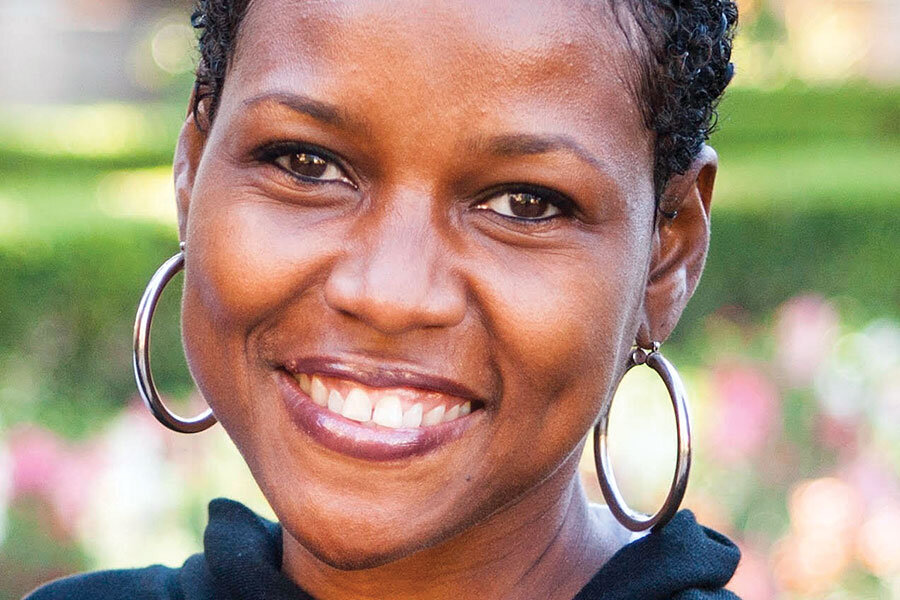East St. Louis has had it tough. But here’s how one woman celebrates the good.
Loading...
| East St. Louis, Ill.
Charmaine Savage wouldn’t want to start a conversation about herself with grim stereotypes of East St. Louis, Ill., her hometown. But her effort to rebrand this struggling city across the Mississippi River from St. Louis with a magazine featuring nothing but success stories wouldn’t stand out so much without acknowledgment of the state of affairs here.
A once-prosperous manufacturing, rail, and shipping center, East St. Louis had a peak population of 80,000 around 1950. That has dwindled to about 25,000 because of deindustrialization, white (and black) flight, violent crime that gives it one of the highest murder rates in the United States, poverty, and corruption.
But that doesn’t account for a tremendous spirit that populates the very air, Ms. Savage says. This town has nurtured African-American icons – from jazz great Miles Davis and singer Tina Turner, to Olympic track star Jackie Joyner-Kersee and renowned sports and race sociologist Harry Edwards, to former US Ambassador to the United Nations Donald McHenry.
It’s the dissonance between the negative image and Savage’s childhood memories of a thriving and safe place for working-class and professional African-Americans that influenced her to move home after a Navy and civil service career.
“This is [what] really hurts me: that we weren’t encouraging people to go learn, earn, and return,” Savage says, tearfully choking up in an interview, as she does frequently in public appearances describing her mission. “Had we known that we would end up with the conditions we have right now, maybe we would have done things a little differently.”
Savage herself returned to live her life a little differently: celebrating, memorializing, and reigniting the spirit of the place by publishing I Am EStL, a high-quality magazine.
Savage is neither a journalist nor a businesswoman with start-up experience. Achieving the rank of commander in the Navy as a human resources professional, she raised a family based in various places from Norfolk, Va., to San Diego, and did a tour of duty in Iraq before retirement.
She says her East St. Louis homecoming in September 2014, on the heels of a life-threatening illness, was a time of searching that culminated in a spiritual epiphany.
Savage says she sat quietly for days while settling in, “waiting for God” to drop an idea on her about how to help her distressed hometown. The answer was not intuitive: Publish a good-news magazine about East St. Louis.
“God definitely spoke to me,” Savage says, “because I didn’t know the first thing about magazine publishing.”
The first issue
Bankrolled by her retirement income and getting a crash course from an old high school classmate who now publishes magazines in Atlanta, Savage launched I Am EStL in January 2016.
The first issue was 44 full-color pages featuring East St. Louis natives, among them city Mayor Emeka Jackson-Hicks, US Sen. Richard Durbin (D) of Illinois, and local high school artists.
Told she could save money on that first issue by using staples instead of higher-quality, glue-based “perfect binding,” she bristled with a perfectionist’s sensibility: “I’m not putting a staple in my magazine ever. I’ll stop printing it before I do that.”
Today she smiles at that, saying it symbolizes her deep faith in East St. Louis: “We need for people to see how amazing we are, the excellence we put into the world and how we show up in the world. I’m out to prove we are excellent, the best of the best.”
Churches amid ruins
A drive around her city can be a harsh reminder of the visual evidence that makes accomplishing her goals so difficult. A tangle of Interstates carves through the city grid without inviting traffic into the downtown, which is full of the ruins of stately classic 19th-century buildings. Traffic lights, where they exist, largely do not work, and every block has burned-out or boarded-up buildings.
And yet, there are 110 operating churches and gestures of marketing for visitors, such as a riverfront park that offers the best and only unobstructed view of the St. Louis Gateway Arch; the Katherine Dunham Museum of African and Caribbean art objects; and the Sacred Sites of the East St. Louis race riots, a self-guided tour of the course of a white mob massacre of blacks in 1917. (Savage is a member of the commission that created markers for the tour.)
And so the magazine is a powerful magnifying glass for the good that does still exist, says Andrew Theising, an associate professor of political science at Southern Illinois University Edwardsville and author of “Made in USA: East St. Louis.” “East St. Louis is a place that’s easy to criticize, so something that sings praise is important and essential.”
The quarterly magazine is distributed free of charge through local businesses, and the online version is also free; but nearly 200 subscribers pay $10 an issue to receive it first. Advertising has grown from none in the first issue to several placements in the latest. With paid freelance writers, graphic artists, and professional photographers, as well as printing – which is done in South Korea via electronic layout and delivered in 12 days or fewer – Savage’s cost per issue is about $5,000.
At first, she says, “I was just willy-nilly [with a credit card]; I had so much fun doing it. But then I started thinking, ‘Charmaine, you know better than this. We don’t have to travel all over the country getting [interviews for] these stories; we’ve got enough people locally to tell their stories.’ ” She also realized that advertising sales were a must.
The operation now generally breaks even with each issue.
The full social spectrum is always featured – such as a federal judge, the couple that runs a longtime family-owned fish market, a county clerk, movie director, handbag designer, graphic artist, tailor, chemist, public works plant manager, chief executive officer. All those profiled work here or are current or former residents (though many baby boomers can’t say they were “born and raised” here, because black people weren’t allowed to give birth in local hospitals until after the civil rights era).
Circulation is small, but 500 to 900 copies of each issue are snapped up quickly.
What others are saying
The magazine “was a shock to my system when I saw it ... the idea, the quality of the magazine,” marvels Charlotte VM Ottley, owner of an advancement and development consultancy in New York, Atlanta, and St. Louis. It reminded her of her own effort to rebrand the city years ago, and she was heartened to see Savage’s idea launch so impressively.
Ms. Ottley now serves on the board of the nonprofit Savage has formed to support rebranding activities such as the magazine and an annual community award for East St. Louis achievers.
Savage is “telling the story that goes against the mythology of East St. Louis,” says Jack Kirkland, an associate professor at the Brown School at Washington University in St. Louis. That, he says, helps his students feel very comfortable volunteering and researching in the city.
Savage’s own choices vouch for that comfort. She and her husband, an architect, became urban pioneers, taking over an old bread bakery where they now live and work. It’s in the Lansdowne area of the city, which has its own share of blight. But, she says, “What people don’t realize is there are a lot of [successful professionals] like my husband and I that live in the city.”
In fact, she says, they don’t realize how much material she has for the magazine. Sometimes her biggest challenge is cutting good stories for lack of space. “I’m struggling with, who do I not put in the magazine? I won’t run out of material.”
• For more, visit IAmEStL.com.
How to take action
UniversalGiving helps people give to and volunteer for top-performing charitable organizations around the world. All the projects are vetted by UniversalGiving; 100 percent of each donation goes directly to the listed cause. Below are links to three groups that tap volunteers to help with communications efforts:
• School the World facilitates a good education for those living in the rural villages of Central America. Take action: Assist in developing partnerships between this organization and media outlets.
• Supporting Kids in Peru helps disadvantaged youths realize their right to an education. Take action: Be a communications officer for this program.
• Romania Animal Rescue aids animals from poor communities, with a focus on spay and neuter services. Take action: Write up accounts and submit them to news outlets to promote this group’s work.






